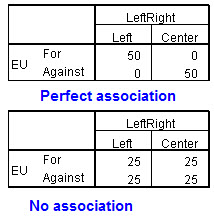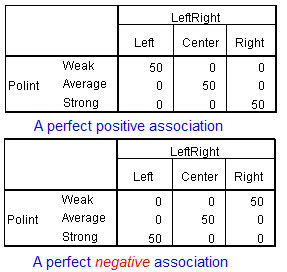Presentation
To study a relationship between categorical variables we can rely on the
examination of the appropriate percentages. To summarize and measure the strength of
a relationship, we can use .
An association coefficient or correlation coefficient is an index of how strong a relationship between
two variables is; a value of 0 indicates no relationship, whereas a value
of, normally, 1 represents the maximum (a few coefficients have a maximum lower
than 1, some can exceed 1 in particular conditions). Coefficients meant for ordinal or higher levels of
measurement are signed to indicate a positive or negative association (direction of the relationship).
There is a large number of association coefficients; they differ for two reasons:
- Measurement level requirements: there are nominal coefficients, ordinal coefficients
etc.
- Statistical approach: There are several types based on different statistical
ideas, for instance there is a family derived from the χ2
statistic.
There are both symmetric and asymmetric association coefficients.
An asymmetric (or directional) coefficient attempts to explain/predict a dependent
variable by an independent, whereas a symmetric one considers
both variables equally. The notation for coefficients that offer
both versions make it clear: For instance a symmetric λ
is noted λxy, whereas there are two asymmetric
versions λx and λy.
Basic principles
 Association coefficients attempt to summarize a relationship. Here you
see two hypothetical situations with no association and perfect association.
Note all coefficient will produce a value of 0 for no association, and
a maximum of usually 1 for the perfect case.
Association coefficients attempt to summarize a relationship. Here you
see two hypothetical situations with no association and perfect association.
Note all coefficient will produce a value of 0 for no association, and
a maximum of usually 1 for the perfect case.
Perfect relationship means that e.g. if we know that
someone is placed on the left, he or she will be "For" the EU, with no exception
whatsoever
in the "no association case" if we know that someone is on the left,
the probability of being "for" or "against" the EU is identical, i.e. no relation whatsoever.
 Here we picture two ordinal variables, where you see two perfect relationships;
the first being positive and the second negative. In the first case the association coefficient
will be +1, -1 in the second.
Here we picture two ordinal variables, where you see two perfect relationships;
the first being positive and the second negative. In the first case the association coefficient
will be +1, -1 in the second.
Important
- An association or correlation coefficient only summarizes a relationship, using a single number that
can never tell the whole story. A crosstabulation on the other hand shows all the details.
- Beware, no single coefficient can be perfect for every situation. The type of data,
the expected form of the relationship, the properties of each measure and the
type of hypothesis about the relationship are central in choosing
an association measure.
- What is a strong association? There is no easy answer to this question, except "it depends".
It depends on the context, the kind of data and phenomenon you are studying.
Coefficients are in fact most useful when you compare tables as they enable you to judge
whether a relationship is weaker or stronger compared to the others.
- Association coefficients summarize simple structures as shown in the examples above; they have usually
trouble summarizing complex relationships.
See also
 Association coefficients attempt to summarize a relationship. Here you
see two hypothetical situations with no association and perfect association.
Note all coefficient will produce a value of 0 for no association, and
a maximum of usually 1 for the perfect case.
Association coefficients attempt to summarize a relationship. Here you
see two hypothetical situations with no association and perfect association.
Note all coefficient will produce a value of 0 for no association, and
a maximum of usually 1 for the perfect case. Here we picture two ordinal variables, where you see two perfect relationships;
the first being positive and the second negative. In the first case the association coefficient
will be +1, -1 in the second.
Here we picture two ordinal variables, where you see two perfect relationships;
the first being positive and the second negative. In the first case the association coefficient
will be +1, -1 in the second.